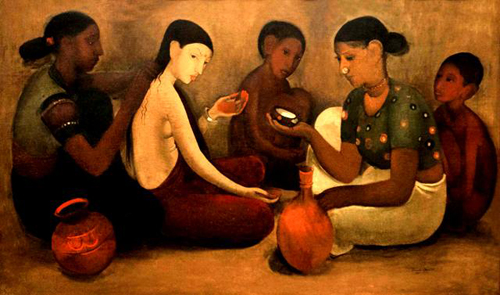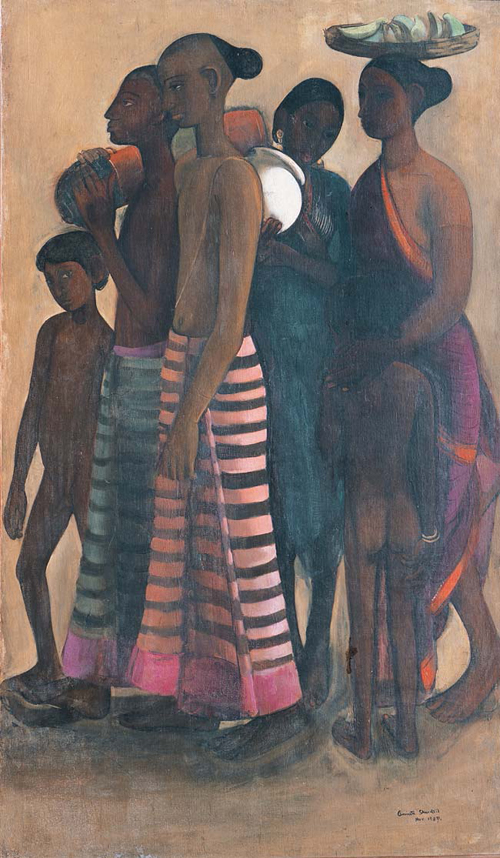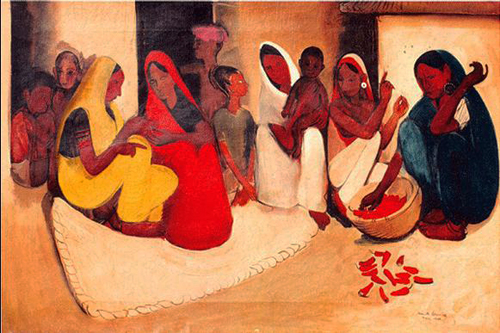
Photograph: [Public Domain] WikiArt
A quest for the Self
In the first extract from her book, The Teachers of One, Paula Marvelly, Editor of The Culturium, recounts her very first spiritual journey to India. After interviewing Advaita teacher, Ramesh Balseker, in Mumbai, she is now ready to embark upon the last leg of her journey to the Ramanasramam, Tiruvannamalai, in a quest to finally discover the answer to the most fundamental question of all, “Who am I?”
“‘I exist’ is the only permanent self-evident experience of everyone. Nothing else is so self-evident as ‘I am’. What people call self-evident, that is, the experience they get through the senses, is far from self-evident. The Self alone is that. So to do Self-enquiry and be that ‘I am’ is the only thing to do. ‘I am’ is reality. I am this or that is unreal. ‘I am’ is truth, another name for Self.”
—Bhagavan Sri Ramana Maharshi
I HAVEN’T SLEPT A WINK. My body is weeping sweat and the pain in my gut has had me writhing on the bed all night, culminating in an acute upset stomach. I feel terrible. Once more, day breaks. The sounds of India seep into my consciousness as I lie in my alien room—strange noises fill the air but not so much the coughing of heating pipes, rather booming Indian television and the strains of toilet flushes.
The taxi arrives first thing in the morning to take me to Mumbai’s Santa Cruz domestic airport. I have booked a ticket with Jet Airways, India’s first commerical airline, to take me to Chennai. I am told the journey to the airport should take about an hour by cab but the driver thinks he is Stirling Moss; the road ahead subsequently turns into a racetrack—buses, rickshaws and fellow members of the human race all serving as chicanes, which he swerves around with terrifying speed.
My fear of flying also rears its ugly head once more, augmented by my weary aching body. I am thrown around the back seat of the taxi not daring to look through the windscreen; it never ceases to amaze me how Indians are unafraid of passing traffic and can walk nonchalantly within millimetres of moving vehicles.
We arrive at the airport within half an hour. “You drive very fast,” I say ironically. But the subtlety is wasted and he turns around and beams delightedly. Indeed his pride is such that he demands a significant tip for getting me here so quickly. What with my overcompensating for delays, I am hours too early. I go through the laborious bureaucratic checks and rechecks of check-in. Then I am told that I can catch the earlier flight to Chennai if I want. Ah ha! This is God telling me something, I think. Fear of flying … arrive too early at airport … offered different plane … what else can it mean except that I am being saved, obviously, from disaster on the original plane. “Yes, great,” I say, “I’ll take it.”
Santa Cruz is a busy domestic airport and there are scores of people milling around awaiting flights. I walk around looking for a vacant seat—again, the usual sea of staring faces. Until now it hasn’t bothered me too much, I have simply looked away. Now I am feeling at a low ebb, the penetrating eyes start to distress me deeply. I start to imagine what it must be like to be famous, to be constantly the centre of attention. I think, in the grand scheme of things, I am glad to be a nobody.
Flying in India is the subject of many jokes—everything on an aeroplane is held together with elastic bands and Elastoplast, they say. Now I am sitting in one, the joke is not quite so funny. But it’s OK. I’m in God’s hands. All is well. The engine starts up and we taxi to the main runway which, like the streets of Mumbai, appears to be strewn with potholes. But it’s OK. I’m in God’s hands. All is well. The plane pauses, waiting for its slot. Then the engines fire up and we’re off. My heart kicks into overdrive. We are hurtling faster and faster along the runway, gathering up speed, ready to reach into the sky …
Suddenly, the plane brakes violently. I am thrown forward in my seat. My head whips down nearly bashing the seat in front of me. I throw my hands out to restrain myself. Jesus holy Christ.
THIS IS IT.
The plane stops dead.
Silence.
I daren’t imagine what’s happening. Oh please God, I don’t want to die. Not like this.
Then the captain’s voice can be heard—a well spoken, English public school accent. “Perhaps we are all wondering what has happened … Some technical problems … We need to sort out the paperwork.” Somehow the sound of a Western male voice takes the edge off things though I would have thought that finding an engineer was the more expedient approach to the problem.
As I look around the cabin, I appear to be the only one who is concerned about our safety. The plane is filled predominantly with well dressed Indians, businessmen presumably, who reach immediately for their mobile phones to convey the bad news that they will be delayed for their rendezvous. The stewardess walks past me along the aisle; I reach out my hand to her, “What’s happened?” “I don’t know, I’m afraid,” she says with that reassuring smile, well practised over many years of having to deal with the general public. “Is it safe?’ I enquire further. “I hope so!” she replies, still seemingly unperturbed. Am I really the only one getting in a panic? Do these people genuinely have no fear of the inevitable, that everything is ultimately God’s will … even aviation disasters?
After an hour, we finally take off, lurching up over the Mumbai landscape heading eastward. I breathe deeply, trying to relax. As I do so, tears well up in my eyes and stream down my cheeks. I am feeling utterly wretched and sorry for myself. Not only do I feel like death warmed up, I am sick of being stared at, tired of wondering whether I can eat this or drink that. I am so very far from home and I feel absolutely alone. For all the sense of relief that Ramesh Balsekar’s teaching had brought during my visit to his home in Mumbai, when push comes to shove, it has all gone out of the window. But surely this is supposed to be the moment when I need it the most? Never before have I felt so attached to my body, to my feelings and my mind.

Photograph: [Public Domain] WikiArt
My chauffeur has been waiting for nearly three hours. He didn’t want to be late so set off in good time. He leads me to his taxi—a brilliant white Ambassador. He proudly opens the door for me and I climb in the back. We then pull away and enter the busy main road out of Chennai towards the south of India.
Fatigue and a growing surrender to the inevitable take hold; the passing madness and chaos, the heat and smell and noise through the open window swirl around my brain. As my vitality fades, I start to slip away into a quiet secluded space in my mind. Darkness and blankness consume me. Resistance failing, I lie on my rucksack and disappear into nothingness …
When I wake up, everything is changed. I have re-emerged into another world. Now, having shed the skin of sleep, I rise up to greet an Arcadian vision. If I had just died and gone to heaven, this would be it, I think. Never in my life have I seen a panoramic landscape of such vivid luminosity, such radiant colour and texture, such exquisite proportion of field and rock and tree.
I feel like I am on a magical mystery tour. My taxi roars along the dusty road, its horn tooting cheekily. I see paddy fields and mountains and lakes emerging before me like the changing set designs in a theatre. Then suddenly, here is a small village, where the men stand in groups discussing who knows what and the women brush out their small reed-thatched homes and tend to their domestic chores. They remind me of the Tahitian women depicted in the paintings of Paul Gauguin—exotic, mysterious and yet a breathtaking expression of nature’s vital force.
We have been on the road for nearly three hours. Then the driver indicates to the horizon over to the right of us: “Arunachala!” he cries. There, in all its magnificence and splendour, a shrine made from earth and rock pointing towards heaven, is Siva’s “sacred red mountain” and home of the great sage, Bhagavan Sri Ramana Maharshi.
The setting sun in the west casts an opaque gauze of light over the landscape. Arunachala is silhouetted against the sky giving it the appearance of not being made of matter but a phantasmagorical image hovering in the air. I can hardly believe I have made it here. After going to hell and back, I have been rewarded with paradise.
The scenery gradually changes from provincial to urban life. Stark white buildings, worn out and dishevelled, replace the idyllic rural huts and crowd up against the main road taking us into Tiruvannamalai in the North Arcot District of Tamil Nadu. The village is a labyrinth of streets, houses and shops decorated here and there with religious symbols, garlands of flowers and multi-coloured bunting. The street is filled with people meandering about herding cows around in every direction, and trucks and rickshaws trying to thread their way through this seemingly random display of human life.
By about five in the afternoon, we arrive at the Ramanasramam. It is situated on a road running out of Tiruvannamalai. It is less ornate and more understated than I had imagined. There is a high stone wall running along the perimeter with lattice gates at the entrance, which are surrounded by beggars and street vendors. We drive into a forecourt surrounded by banyan trees. I get out and the taxi driver escorts me to the general office where I am greeted by a suave Indian man wearing a white shirt and dhoti. He is called Sri Nivasamurthy or more affectionately, the Doctor, and is the ashram’s GP. He greets me cordially and asks me to sign a huge leather-bound ledger. I am handed the daily schedule and requested, politely, to attend as many of the events mentioned as possible, as well as remembering to dress modestly within the ashram. I then return to the taxi and we leave the compound, journeying to the women’s quarters, 500 yards or so down the road.

Photograph: [Public Domain] WikiArt
Hanging on the wall next to the desk is a black and white photograph of Ramana lying on a couch, wearing reading glasses. He is studying a letter, whilst a small rabbit has snuggled up beside him. Beneath the picture is a long quote written in Tamil, under which is a translation:
Like the string that holds together the gems in a necklace, You it is that penetrate and bind all beings and the various religions. If like a gem that is cut and polished, the separate mind is whetted on the grindstone of the pure Universal Mind, it will acquire the light of your grace and shine like a ruby whose brightness is not flawed by any other object. When once the light of the Sun has fallen on a sensitive plate, will the plate register another picture? Apart from you, O Aruna Mountain bright, auspicious, does any other thing exist?
—Bhagavan Sri Ramana Maharshi, Sri Arunachala Ashtakam
The electric fan purrs overhead as I unpack. Such has been the assault on my senses that I have not had time to think about my body and its various demands. Now I am safely installed in my room, physical sentience returns with a vengeance. Supper is at seven but I just cannot face it so I lie on the bed to sleep …
I awaken to a lightning flash and the crack of thunder. I can hear the sound of shouting and chanting as well as the banging of drums and tooting of car horns in the near distance. I have no idea of the time but it is dark outside. It is also raining and the water drops are pounding on the windows and grilles. Why is it in India everything seems to be so much more alive and real, so much more intense? I cannot for the life of me imagine what is happening outside except that there must be some celebration, some invocation of the gods. But for so long? It is well past four in the morning before the cries fade into the distance and the rain subsides to a drizzle.
The following morning is bright and fresh. My mind is clear and alert, despite the body feeling weak and dizzy. A distance seemingly separates me from the actions that my body performs—washing, getting dressed, making the bed. Everything is flowing with an ease and effortlessness, devoid of the usual running commentary of self-consciousness, retribution and angst. It is half-past six and I walk into the ashram, taking a path that leads parallel to the tank, where monkeys are playing in the trees and dragonflies are darting through the grass. I enter the ashram through a back entrance, leaving my shoes at the gate. I emerge just behind the Main Hall but I cannot go in as it has been flooded by the night’s heavy rain and numerous people are now bustling about with reed brushes, sweeping out the water.
As I stand outside the entrance, I notice a group of Westerners and ask them what all the noise was about the previous evening. “It was because of the full moon—people make the 14-kilometre circuit of the hill. And if you make a wish while you are doing it, it is supposed to come true.” “You have come at a very auspicious time,” another one of them continues, “for not only is today Friday 13th but 13th October is also Papaji’s birthday.” When I reflect on my short time in India, everything seems to have been done at an auspicious moment. Am I just lucky or do Indians have the ability to turn any normal situation into some kind of divine coincidence?
The most popular time to come to Tiruvannamalai is, however, during the November full moon, known as the Karthikai Deepam Festival. Legend has it that Siva appeared as a column of fire on Arunachala Hill. The story goes that, owing to the disputes between Vishnu and Brahma about which one was the greater, Siva manifested himself as a blazing column. He then told them that the one who could find the upper or lower end of the column was the greater of the two. Vishnu, representing ego or individuality, transformed himself into a boar, burrowing downwards in search of the base; Brahma, meanwhile, representing the intellect, changed himself into a swan and flew upwards to seek the column’s summit. On his way up, Brahma caught a flower falling from a mountain tree and, returning to Siva, declared that he was the winner, claiming that the flower had come from the top of the column.
Vishnu however, forgetting his mission, became absorbed in meditative contemplation. Returning finally, he admitted his failure in the search, acknowledging that Siva was indeed without beginning, middle or end, being the Supreme Spirit. Despite his not completing the task, Vishnu was nevertheless pronounced the victor in recognition of his insight. And it is this legend that is still celebrated every year with a huge fire, called the Lingam of Fire, which burns for many days on the summit.
Sri Ramana Maharshi also acknowledged the sanctity of the hill, saying that it was the heart and spiritual centre of the world. He recommended that devotees make the circuit of the hill, called pradakshinam, advising them to make the journey slow and deliberate, “like a woman in her ninth month of pregnancy”. Indeed, there is an old saying that the hill is wish-fulfilling, though paradoxically the highest wish of all, as Ramana pointed out, is the state of no longer wishing for anything.

Photograph: [Public Domain] WikiArt
People start to drift in the direction of the dining hall for breakfast. We pass into a small courtyard where there is a huge well. Ordinarily, the water is 40 feet or more below the rim but owing to the night’s heavy rain the water level is nearly at the top. People are peering over the ledge to look at it. Sri Sundaram Ramanan or simply Mr Ramanan, the ashram President, and the Doctor stand at the foot of the dining hall steps next to the well, greeting all the ashram residents as they pass into the hall.
Palm leaves are arranged in rows on the red-tiled floor, which is worn and scratched by the hundreds of devotees who have been served food before us. We all file in and then sit down on the ground. From the kitchen, men appear carrying large metal buckets. They start walking up and down each row, distributing food. One brings idli, a soft rice cake, and another vegetable curry, which he pours onto my palm leaf with perfect precision from a ladle suspended high in the air. Then others come around with buckets of sweet hot coffee or buttermilk, made from the ashram’s own dairy—the cows are direct descendants from Ramana’s favourite cow, Lakshmi.
On one side of the room, there is a small altar to Ramana. There is also a small bowl of flowers as well as a picture of him sitting on the ground eating, his hand cupped holding food. One or two people kneel before the picture before they take their places on the floor. The rest of the hall is like a portrait gallery of the world’s greatest holy men and women. As well as numerous pictures of Ramana, other portraits include Jesus, Nisargadatta Maharaj and Papaji, as well as an array of other male and female teachers less familiar to me.
Conversation is not encouraged in the dining hall. I consume as much as my stomach will allow, all the while trying to master eating with my right hand. Even with a simple meal on a palm leaf, there is a code of conduct; to indicate I have finished, I fold over the leaf. I then get up and leave, stopping at the water tank to replenish my water supply.
I desperately want to explore but know instinctively it is important to rest and recover my strength. I, therefore, spend most of the day dozing in my room, listening to the strange sounds around me, trying to just go with the flow …
I am in a car being driven very fast. I am in San Francisco on a road running along the side of a mountain. The landscape tips over. The car and the driver fall over the edge … I am left clinging for my life on the ledge of the mountain. Then the ledge turns into an aeroplane. The back door is open and I am hanging onto it, swinging from its hinges. The plane is about to crash into the sea … I am being chased by a dark-coloured man. I am sitting on a balustrade. The man pushes me off and I fall backwards into a deep cavern, which is filled with black oil. I fall into the oil and sink deeper and deeper. The oil fills my lungs. I cannot breathe …
[Extract: Paula Marvelly, The Teachers of One: Conversations on the Nature of Nonduality]

Photograph: [Public Domain] WikiArt
